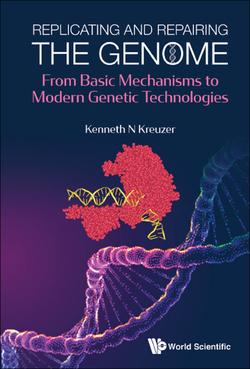Читать книгу Replicating And Repairing The Genome: From Basic Mechanisms To Modern Genetic Technologies - Kenneth N Kreuzer - Страница 40
На сайте Литреса книга снята с продажи.
Chapter 4 Eukaryotic DNA replication
ОглавлениеNormal diploid human cells carry 46 linear chromosomes: two each of the 22 autosomes and two sex chromosomes. Chromosome numbers in this range are quite typical throughout the animal kingdom, although cells of some animal species have more than 100 chromosomes, and certain plant cells even more (e.g., well over 1000 in a particular fern species). While the number of chromosomes per cell can be large depending on the species, in every case, each and every chromosome must be replicated once and only once per cell cycle. The two replicated copies of each chromosome must also be segregated correctly, one into each of the two daughter cells. Both of these processes have a very low error rate. However, failures do occur, often resulting in non-viable daughter cells or contributing to cancer formation in metazoans.
The machinery that replicates chromosomes in eukaryotic cells is significantly more complex than that of prokaryotes. As we will see, this complexity allows a high degree of flexibility in the replication program and a remarkable degree of regulation to ensure a high probability of correctly replicating each chromosome once and only once. Some of the basic machinery involved in replication is conserved throughout evolution, and proteins involved in replication from bacteria to humans show many commonalities in protein structure and molecular mechanisms. In this Chapter, we will focus on the eukaryotic replisome machine and how it functions to duplicate the chromosomal DNA. In the following Chapter, we will shift our attention to how replication is initiated at replication origins, regulated both at the initiation and later stages, and how replication is completed prior to cell division.
The exact number of proteins involved in eukaryotic DNA replication is still not known and almost certainly varies between disparate species. Nonetheless, the number of different proteins is clearly much higher than in prokaryotes, for at least three major reasons (described in more detail in ensuing sections). First, multimeric proteins that are composed of identical subunits in prokaryotes are instead composed of different but related subunits in eukaryotes (for example, the hexameric replicative helicase). Second, eukaryotes were found to have multiple forms of certain key replication protein complexes, each with specialized functions, in contrast to a singular form in prokaryotes (for example, both clamps and clamp loaders). Third, eukaryotic replication systems must deal with additional complexities such as replicating DNA that contains nucleosomes and preparing their multiple chromosomes for accurate segregation. Many additional proteins, including some that travel with the replication fork, are involved in these processes. The growing list of eukaryotic replication proteins is quite staggering, as indicated by Tables 1 and 2 in the Appendix. In these Chapters, we will again try to minimize the nomenclature to keep the focus on important concepts and functions. A few important and commonly used names will be introduced, particularly when these proteins are also central in other cellular functions such as DNA damage responses and DNA repair.
